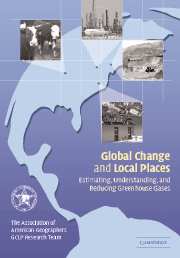Book contents
- Frontmatter
- Contents
- List of contributors
- Foreword
- Preface
- Acknowledgments
- Part One Global change and local places
- Part Two Learning from localities
- 3 Global change and Southwestern Kansas: local emissions and non-local determinants
- 4 Northwestern North Carolina: local diversity in an era of change
- 5 Northwestern Ohio: re-industrialization and emission reduction
- 6 Global change and Central Pennsylvania: local resources and impacts of mitigation
- Part Three Beyond Kyoto I: greenhouse gas reduction in local places
- Part Four Beyond Kyoto II: greenhouse gas reduction potentials and strategies
- Index
- References
3 - Global change and Southwestern Kansas: local emissions and non-local determinants
Published online by Cambridge University Press: 31 July 2009
- Frontmatter
- Contents
- List of contributors
- Foreword
- Preface
- Acknowledgments
- Part One Global change and local places
- Part Two Learning from localities
- 3 Global change and Southwestern Kansas: local emissions and non-local determinants
- 4 Northwestern North Carolina: local diversity in an era of change
- 5 Northwestern Ohio: re-industrialization and emission reduction
- 6 Global change and Central Pennsylvania: local resources and impacts of mitigation
- Part Three Beyond Kyoto I: greenhouse gas reduction in local places
- Part Four Beyond Kyoto II: greenhouse gas reduction potentials and strategies
- Index
- References
Summary
Landscape, life, and livelihood
The Southwestern Kansas study area (Figure 2.1) lies within the American High Plains, a semi-arid region west of the 100° meridian that extends northward from West Texas through Kansas and Nebraska to the Dakotas. Characterized by nineteenth century explorers as the ‘Great American Desert,’ the first European-American landholders introduced cattle ranching to this nearly treeless shortgrass prairie. Through the Homesteading Act and the efforts of railroads, much of the High Plains was settled by crop farmers in the late nineteenth century. The area of land successfully cultivated varied with precipitation cycles, however, and the particularly long dry spell that occurred in the 1930s resulted in land abandonment through much of the region, lending the High Plains a new name: The Dust Bowl.
The study site lies at the center of the High Plains and in the heart of the former Dust Bowl. Its six counties encompass an area of approximately 14,120 square kilometers (5,450 square miles), inhabited by slightly more than 90,000 people and over 900,000 cattle. The three principal settlements are Garden City (2000 population of 28,451), Dodge City (25,276), and Liberal (19,666). Southwestern Kansas lies at relatively high elevation: 610–1,070 m (2,000–3,500 ft) above sea level, but contains little internal topographical relief.
The study area's climate is semi-arid with mean monthly temperatures ranging from -1 to +27°C (30–80°F). Precipitation averages less than 58 cm (23 in) per year, most of which falls as spring and summer rain (Goodin et al. 1995).
- Type
- Chapter
- Information
- Global Change and Local PlacesEstimating, Understanding, and Reducing Greenhouse Gases, pp. 57 - 78Publisher: Cambridge University PressPrint publication year: 2003
References
- 2
- Cited by



